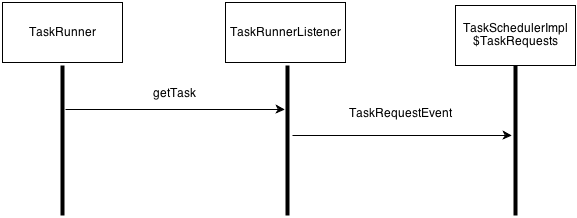Terminology
- Execution Block - A distributed query plan consists of a tree of execution blocks. In other words, a logical plan of a query statement is broken into multiple parts, each of which is included in an execution block. Each execution block is a distributed processing phase which is similar to map or reduce phase in MapReduce. A number of tasks are created with the logical plan and control flags of an execution block.
- SubQuery - It is a control instance and a state machine for an execution block.
- QueryUnit (Task) - QueryUnit indicates a Task. In the design stage, we named QueryUnit to indicate a task. Recently, we are changing QueryUnit to Task.
- QueryUnitAttempt - Like MapReduce, each running query unit (task) has an attempt instance and an attempt id. A task can be restarted if it is failed. So, we need a way to identify failed or succeeded tasks.
TaskRunnerLaunchImpl class
The main objective of TaskRunnerLaunchImpl is to launch TaskRunner through Yarn's ContainerManager.
The TaskRunnerLaunchImpl class handles two events CONTAINER_REMOTE_LAUNCH and CONTAINER_REMOTE_CLEANUP, which lead to launching a TaskRunner and killing a running TaskRunner respectively. These events come from SubQuery::allocateContainers(SubQuery) method.
Task
In TaskRunner, a Task is created from the response (QueryUnitRequest) of 'getTask()' rpc call. Task contains three main attributes as follows:
- A logical plan of an execution block which created the task.
- A fragment - an input path, an offset range, and schema. This is available only if the execution is leaf.
- Fetch URIs - HTTP URIs to fetch the results processed by TaskRunners of the previous execution block. This is available only if the execution is non-leaf.
Initially, a Task registers fetch URIs to fetchLauncher (ExecutorService) in order to pull data, and it restore a logical plan.
Then, a physical operator tree is created from the logical plan via PhysicalPlannerImpl. Finally, Task::run() method is called, and then Task's status is changed to RUNNING.
Also, a running Task periodically sends a statusUpdate report to TaskRunnerListener via RPC. A StatusUpdate report includes a status and some statistics of the running task.
If the running task is failed, TaskRunner sends a message 'fatal' to TaskRunnerListenerImpl.
If the task is completed, TaskRunner sends a message 'done' to TaskRunnerListenerImpl.
TaskRunner
For each execution block, TaskRunner is launched by Yarn's ContainerManager. TaskRunner processes a Task at a time. If TaskRunner has an available slot, it sends 'getTask' to TaskRunnerListner. If TaskRunner receives the response (QueryUnitRequest) of 'getTask' message, TaskRunner creates an instance of Task from the response.
TaskListenerImpl
It receives messages sent from a number of TaskRunners. It passes the received message as events to some event handlers, such as QueryUnitAttempt and TaskScheduler.
In the current implementation, there are four messages as follows:
- getTask
- When a TaskRunner has an empty slot, the TaskRunner sends this message to the TaskListenerImpl. This message is transformed to a TaskRequestEvent which is passed to the TaskSchedulerImpl$TaskRequests instance.
- statusUpdate
- a Task periodically sends this message to TaskRunnerListener via RPC. This message is transformed to a TaskAttemptStatusUpdateEvent which is passed to the QueryUnitAttempt instance corresponding to the identifier included in the statusUpdate message.
- done
- When a task attempt is completed, a Task sends this message to the TaskListenerImpl via RPC. This message is transformed to a TaskCompletionEvent which is passed to the QueryUnitAttempt instance corresponding to the identifier included in the done message.
- fatal
- When a task is failed, the task sends this message to the TaskRunnerListenerImpl via RPC. This message is transformed to a TaskFatalErrorEvent which is also passed to the QueryUnitAttempt instance corresponding to the identifier included in the fatal message.

